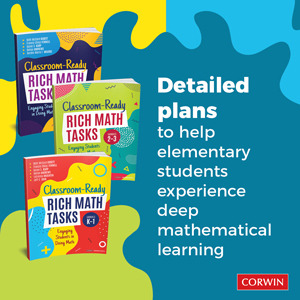Classroom-Ready Rich Math Tasks, Grades K-1
Engaging Students in Doing Math
- Beth McCord Kobett - Stevenson University
- Francis (Skip) Fennell - McDaniel College, USA
- Karen S. Karp - Johns Hopkins University
- Delise Andrews - Lincoln Public Schools, Nebraska
- Latrenda Knighten
- Jeff Shih - University of Nevada, Las Vegas, USA
Corwin Mathematics Series
Do you work tirelessly to make your math lessons meaningful, challenging, accessible, and engaging? Do you spend hours you don’t have searching for, adapting, and creating tasks to provide rich experiences for your students that supplement your mathematics curriculum? Help has arrived! Classroom Ready-Rich Math Tasks for Grades K-1 details 56 research- and standards-aligned, high-cognitive-demand tasks that will have your students doing deep-problem-based learning. These ready-to-implement, engaging tasks connect skills, concepts and practices, while encouraging students to reason, problem-solve, discuss, explore multiple solution pathways, connect multiple representations, and justify their thinking. They help students monitor their own thinking and connect the mathematics they know to new situations. In other words, these tasks allow students to truly do mathematics! Written with a strengths-based lens and an attentiveness to all students, this guide includes:
• Complete task-based lessons, referencing mathematics standards and practices, vocabulary, and materials
• Downloadable planning tools, student resource pages, and thoughtful questions, and formative assessment prompts
• Guidance on preparing, launching, facilitating, and reflecting on each task
• Notes on access and equity, focusing on students’ strengths, productive struggle, and distance or alternative learning environments.
With concluding guidance on adapting or creating additional rich tasks for your students, this guide will help you give all of your students the deepest, most enriching and engaging mathematics learning experience possible.
This book is designed explicitly to support teachers as they reflect on their math teaching practice either individually—or in collaboration with colleagues. Not only does it pull together the essential research connected to planning, setup, and implementation of high-cognitive-demand tasks, it also helps them to implement a full, ready-made collection of tasks, and then eventually move to selecting, adapting, and creating tasks on their own.



